Financial Resources and Decisions: Analysis and Management Report
VerifiedAdded on 2020/01/07
|18
|5045
|278
Report
AI Summary
This report delves into the critical aspects of managing financial resources within a small-scale public enterprise. It begins by exploring various sources of finance, such as bank loans, SBA loans, loans from relatives, share issues, and retained earnings, evaluating their implications and appropriateness. The report then examines the costs associated with each source, including interest rates, fees, and dilution of ownership. Financial planning is highlighted as essential for business stability, covering objectives, policies, and the importance of stakeholder information. Internal and external stakeholders, including employees, owners, managers, creditors, and investors, and their information needs are discussed. Finally, the report emphasizes the impact of financial transactions on financial statements, such as the balance sheet and profit and loss account. The report concludes with a recommendation for a bank loan as a suitable funding source for the enterprise.

Managing Financial
Resources and Decisions
Resources and Decisions
Paraphrase This Document
Need a fresh take? Get an instant paraphrase of this document with our AI Paraphraser
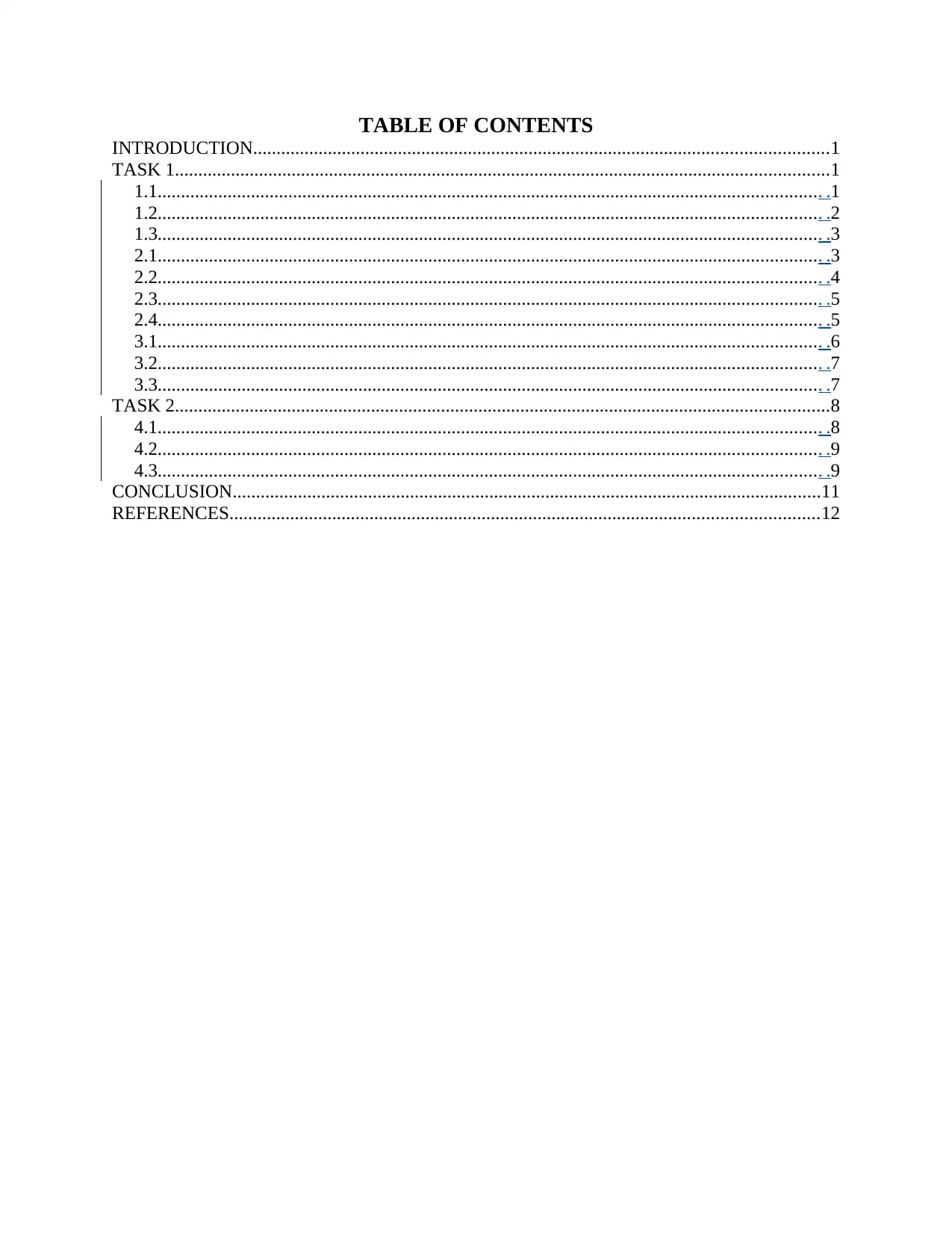
TABLE OF CONTENTS
INTRODUCTION...........................................................................................................................1
TASK 1............................................................................................................................................1
1.1.............................................................................................................................................. .1
1.2.............................................................................................................................................. .2
1.3.............................................................................................................................................. .3
2.1.............................................................................................................................................. .3
2.2.............................................................................................................................................. .4
2.3.............................................................................................................................................. .5
2.4.............................................................................................................................................. .5
3.1.............................................................................................................................................. .6
3.2.............................................................................................................................................. .7
3.3.............................................................................................................................................. .7
TASK 2............................................................................................................................................8
4.1.............................................................................................................................................. .8
4.2.............................................................................................................................................. .9
4.3.............................................................................................................................................. .9
CONCLUSION..............................................................................................................................11
REFERENCES..............................................................................................................................12
INTRODUCTION...........................................................................................................................1
TASK 1............................................................................................................................................1
1.1.............................................................................................................................................. .1
1.2.............................................................................................................................................. .2
1.3.............................................................................................................................................. .3
2.1.............................................................................................................................................. .3
2.2.............................................................................................................................................. .4
2.3.............................................................................................................................................. .5
2.4.............................................................................................................................................. .5
3.1.............................................................................................................................................. .6
3.2.............................................................................................................................................. .7
3.3.............................................................................................................................................. .7
TASK 2............................................................................................................................................8
4.1.............................................................................................................................................. .8
4.2.............................................................................................................................................. .9
4.3.............................................................................................................................................. .9
CONCLUSION..............................................................................................................................11
REFERENCES..............................................................................................................................12
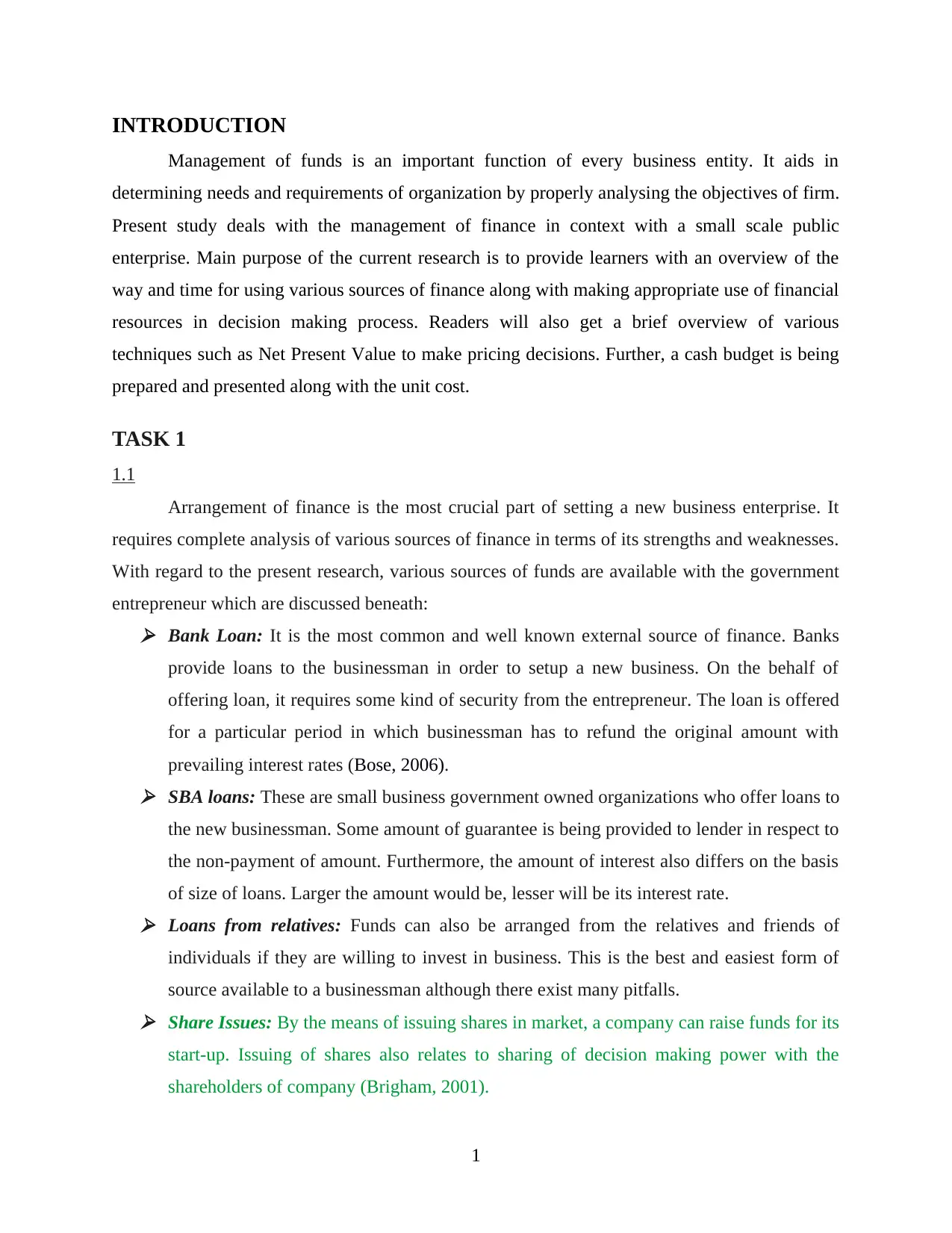
INTRODUCTION
Management of funds is an important function of every business entity. It aids in
determining needs and requirements of organization by properly analysing the objectives of firm.
Present study deals with the management of finance in context with a small scale public
enterprise. Main purpose of the current research is to provide learners with an overview of the
way and time for using various sources of finance along with making appropriate use of financial
resources in decision making process. Readers will also get a brief overview of various
techniques such as Net Present Value to make pricing decisions. Further, a cash budget is being
prepared and presented along with the unit cost.
TASK 1
1.1
Arrangement of finance is the most crucial part of setting a new business enterprise. It
requires complete analysis of various sources of finance in terms of its strengths and weaknesses.
With regard to the present research, various sources of funds are available with the government
entrepreneur which are discussed beneath: Bank Loan: It is the most common and well known external source of finance. Banks
provide loans to the businessman in order to setup a new business. On the behalf of
offering loan, it requires some kind of security from the entrepreneur. The loan is offered
for a particular period in which businessman has to refund the original amount with
prevailing interest rates (Bose, 2006). SBA loans: These are small business government owned organizations who offer loans to
the new businessman. Some amount of guarantee is being provided to lender in respect to
the non-payment of amount. Furthermore, the amount of interest also differs on the basis
of size of loans. Larger the amount would be, lesser will be its interest rate. Loans from relatives: Funds can also be arranged from the relatives and friends of
individuals if they are willing to invest in business. This is the best and easiest form of
source available to a businessman although there exist many pitfalls. Share Issues: By the means of issuing shares in market, a company can raise funds for its
start-up. Issuing of shares also relates to sharing of decision making power with the
shareholders of company (Brigham, 2001).
1
Management of funds is an important function of every business entity. It aids in
determining needs and requirements of organization by properly analysing the objectives of firm.
Present study deals with the management of finance in context with a small scale public
enterprise. Main purpose of the current research is to provide learners with an overview of the
way and time for using various sources of finance along with making appropriate use of financial
resources in decision making process. Readers will also get a brief overview of various
techniques such as Net Present Value to make pricing decisions. Further, a cash budget is being
prepared and presented along with the unit cost.
TASK 1
1.1
Arrangement of finance is the most crucial part of setting a new business enterprise. It
requires complete analysis of various sources of finance in terms of its strengths and weaknesses.
With regard to the present research, various sources of funds are available with the government
entrepreneur which are discussed beneath: Bank Loan: It is the most common and well known external source of finance. Banks
provide loans to the businessman in order to setup a new business. On the behalf of
offering loan, it requires some kind of security from the entrepreneur. The loan is offered
for a particular period in which businessman has to refund the original amount with
prevailing interest rates (Bose, 2006). SBA loans: These are small business government owned organizations who offer loans to
the new businessman. Some amount of guarantee is being provided to lender in respect to
the non-payment of amount. Furthermore, the amount of interest also differs on the basis
of size of loans. Larger the amount would be, lesser will be its interest rate. Loans from relatives: Funds can also be arranged from the relatives and friends of
individuals if they are willing to invest in business. This is the best and easiest form of
source available to a businessman although there exist many pitfalls. Share Issues: By the means of issuing shares in market, a company can raise funds for its
start-up. Issuing of shares also relates to sharing of decision making power with the
shareholders of company (Brigham, 2001).
1
⊘ This is a preview!⊘
Do you want full access?
Subscribe today to unlock all pages.

Trusted by 1+ million students worldwide
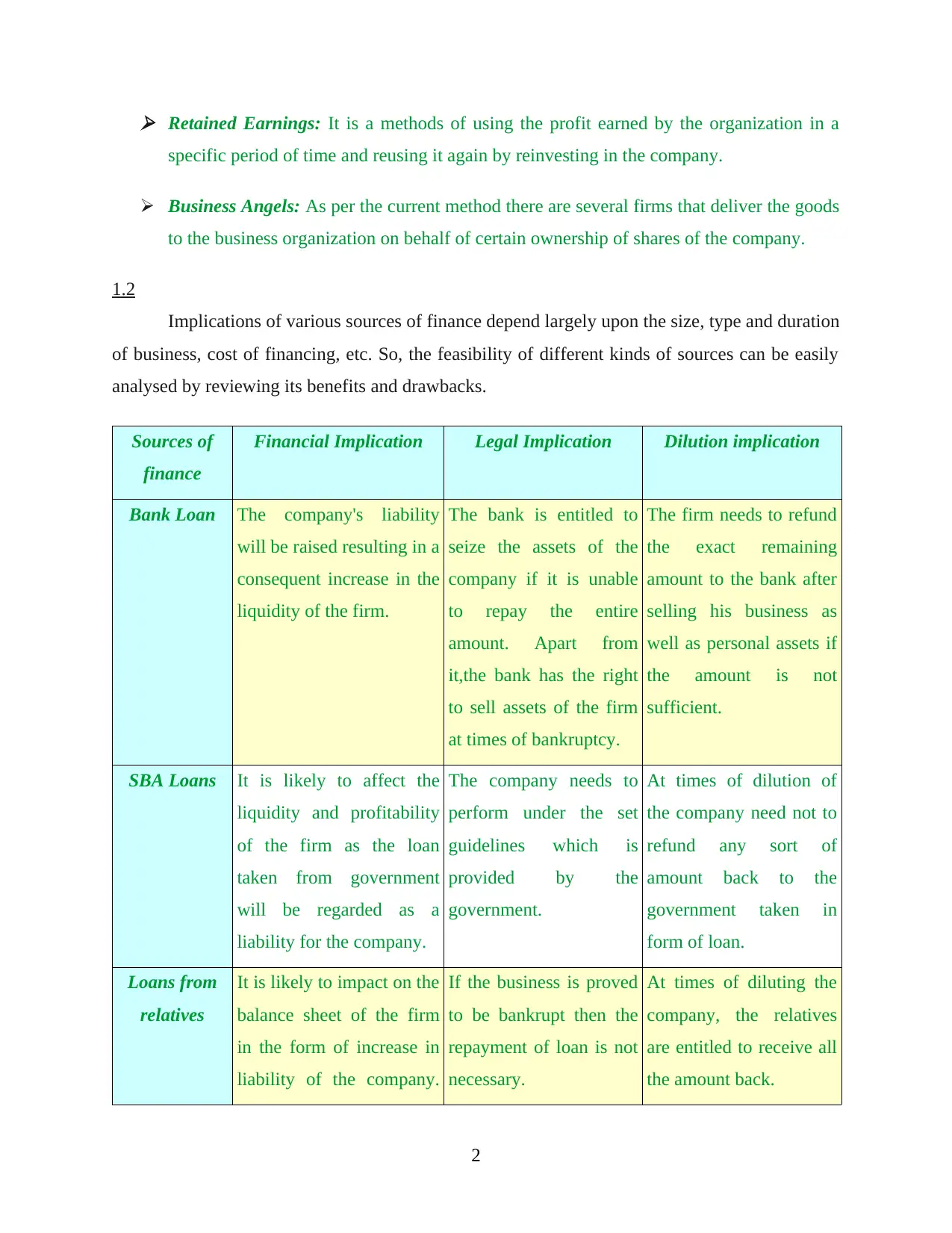
Retained Earnings: It is a methods of using the profit earned by the organization in a
specific period of time and reusing it again by reinvesting in the company.
Business Angels: As per the current method there are several firms that deliver the goods
to the business organization on behalf of certain ownership of shares of the company.
1.2
Implications of various sources of finance depend largely upon the size, type and duration
of business, cost of financing, etc. So, the feasibility of different kinds of sources can be easily
analysed by reviewing its benefits and drawbacks.
Sources of
finance
Financial Implication Legal Implication Dilution implication
Bank Loan The company's liability
will be raised resulting in a
consequent increase in the
liquidity of the firm.
The bank is entitled to
seize the assets of the
company if it is unable
to repay the entire
amount. Apart from
it,the bank has the right
to sell assets of the firm
at times of bankruptcy.
The firm needs to refund
the exact remaining
amount to the bank after
selling his business as
well as personal assets if
the amount is not
sufficient.
SBA Loans It is likely to affect the
liquidity and profitability
of the firm as the loan
taken from government
will be regarded as a
liability for the company.
The company needs to
perform under the set
guidelines which is
provided by the
government.
At times of dilution of
the company need not to
refund any sort of
amount back to the
government taken in
form of loan.
Loans from
relatives
It is likely to impact on the
balance sheet of the firm
in the form of increase in
liability of the company.
If the business is proved
to be bankrupt then the
repayment of loan is not
necessary.
At times of diluting the
company, the relatives
are entitled to receive all
the amount back.
2
specific period of time and reusing it again by reinvesting in the company.
Business Angels: As per the current method there are several firms that deliver the goods
to the business organization on behalf of certain ownership of shares of the company.
1.2
Implications of various sources of finance depend largely upon the size, type and duration
of business, cost of financing, etc. So, the feasibility of different kinds of sources can be easily
analysed by reviewing its benefits and drawbacks.
Sources of
finance
Financial Implication Legal Implication Dilution implication
Bank Loan The company's liability
will be raised resulting in a
consequent increase in the
liquidity of the firm.
The bank is entitled to
seize the assets of the
company if it is unable
to repay the entire
amount. Apart from
it,the bank has the right
to sell assets of the firm
at times of bankruptcy.
The firm needs to refund
the exact remaining
amount to the bank after
selling his business as
well as personal assets if
the amount is not
sufficient.
SBA Loans It is likely to affect the
liquidity and profitability
of the firm as the loan
taken from government
will be regarded as a
liability for the company.
The company needs to
perform under the set
guidelines which is
provided by the
government.
At times of dilution of
the company need not to
refund any sort of
amount back to the
government taken in
form of loan.
Loans from
relatives
It is likely to impact on the
balance sheet of the firm
in the form of increase in
liability of the company.
If the business is proved
to be bankrupt then the
repayment of loan is not
necessary.
At times of diluting the
company, the relatives
are entitled to receive all
the amount back.
2
Paraphrase This Document
Need a fresh take? Get an instant paraphrase of this document with our AI Paraphraser
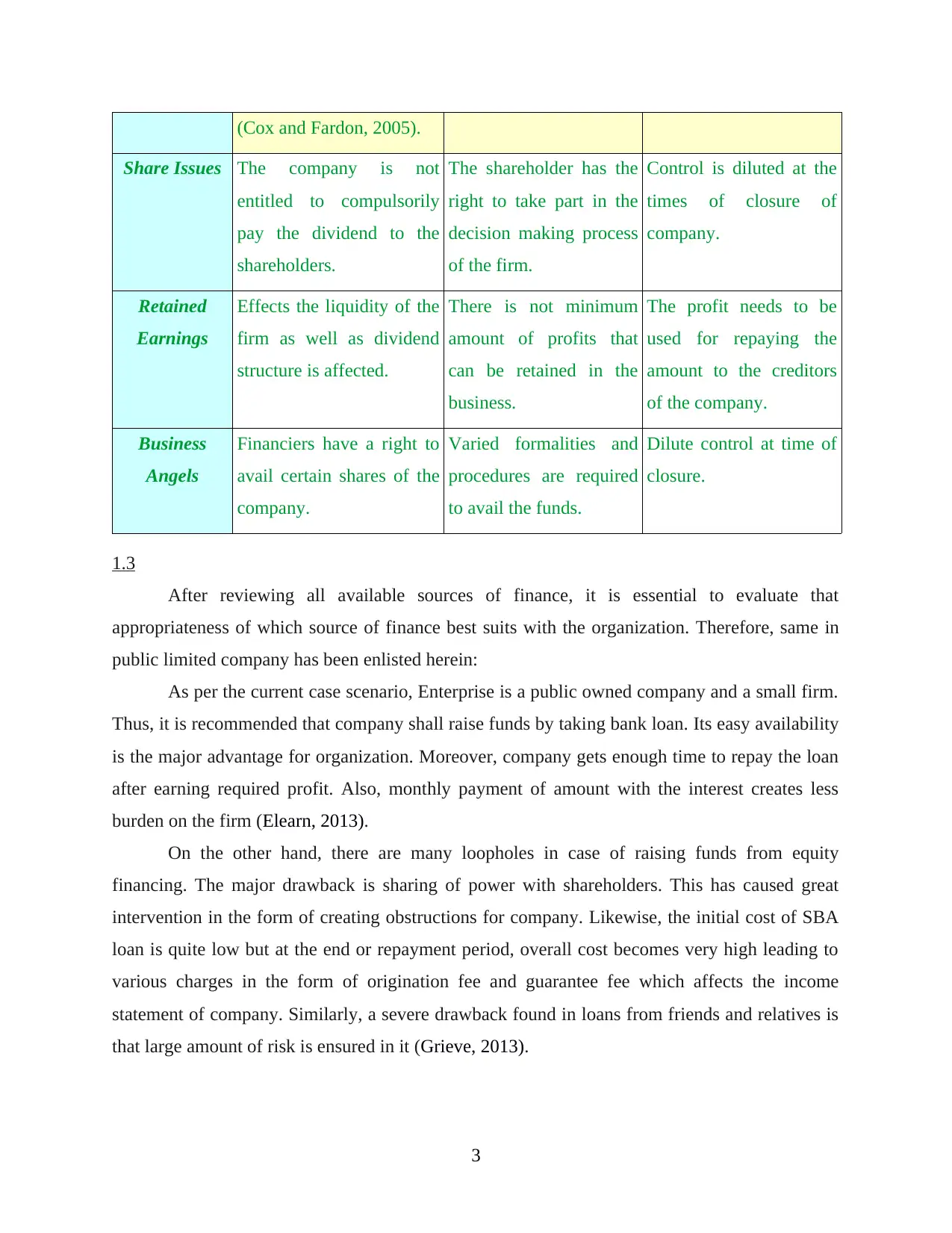
(Cox and Fardon, 2005).
Share Issues The company is not
entitled to compulsorily
pay the dividend to the
shareholders.
The shareholder has the
right to take part in the
decision making process
of the firm.
Control is diluted at the
times of closure of
company.
Retained
Earnings
Effects the liquidity of the
firm as well as dividend
structure is affected.
There is not minimum
amount of profits that
can be retained in the
business.
The profit needs to be
used for repaying the
amount to the creditors
of the company.
Business
Angels
Financiers have a right to
avail certain shares of the
company.
Varied formalities and
procedures are required
to avail the funds.
Dilute control at time of
closure.
1.3
After reviewing all available sources of finance, it is essential to evaluate that
appropriateness of which source of finance best suits with the organization. Therefore, same in
public limited company has been enlisted herein:
As per the current case scenario, Enterprise is a public owned company and a small firm.
Thus, it is recommended that company shall raise funds by taking bank loan. Its easy availability
is the major advantage for organization. Moreover, company gets enough time to repay the loan
after earning required profit. Also, monthly payment of amount with the interest creates less
burden on the firm (Elearn, 2013).
On the other hand, there are many loopholes in case of raising funds from equity
financing. The major drawback is sharing of power with shareholders. This has caused great
intervention in the form of creating obstructions for company. Likewise, the initial cost of SBA
loan is quite low but at the end or repayment period, overall cost becomes very high leading to
various charges in the form of origination fee and guarantee fee which affects the income
statement of company. Similarly, a severe drawback found in loans from friends and relatives is
that large amount of risk is ensured in it (Grieve, 2013).
3
Share Issues The company is not
entitled to compulsorily
pay the dividend to the
shareholders.
The shareholder has the
right to take part in the
decision making process
of the firm.
Control is diluted at the
times of closure of
company.
Retained
Earnings
Effects the liquidity of the
firm as well as dividend
structure is affected.
There is not minimum
amount of profits that
can be retained in the
business.
The profit needs to be
used for repaying the
amount to the creditors
of the company.
Business
Angels
Financiers have a right to
avail certain shares of the
company.
Varied formalities and
procedures are required
to avail the funds.
Dilute control at time of
closure.
1.3
After reviewing all available sources of finance, it is essential to evaluate that
appropriateness of which source of finance best suits with the organization. Therefore, same in
public limited company has been enlisted herein:
As per the current case scenario, Enterprise is a public owned company and a small firm.
Thus, it is recommended that company shall raise funds by taking bank loan. Its easy availability
is the major advantage for organization. Moreover, company gets enough time to repay the loan
after earning required profit. Also, monthly payment of amount with the interest creates less
burden on the firm (Elearn, 2013).
On the other hand, there are many loopholes in case of raising funds from equity
financing. The major drawback is sharing of power with shareholders. This has caused great
intervention in the form of creating obstructions for company. Likewise, the initial cost of SBA
loan is quite low but at the end or repayment period, overall cost becomes very high leading to
various charges in the form of origination fee and guarantee fee which affects the income
statement of company. Similarly, a severe drawback found in loans from friends and relatives is
that large amount of risk is ensured in it (Grieve, 2013).
3
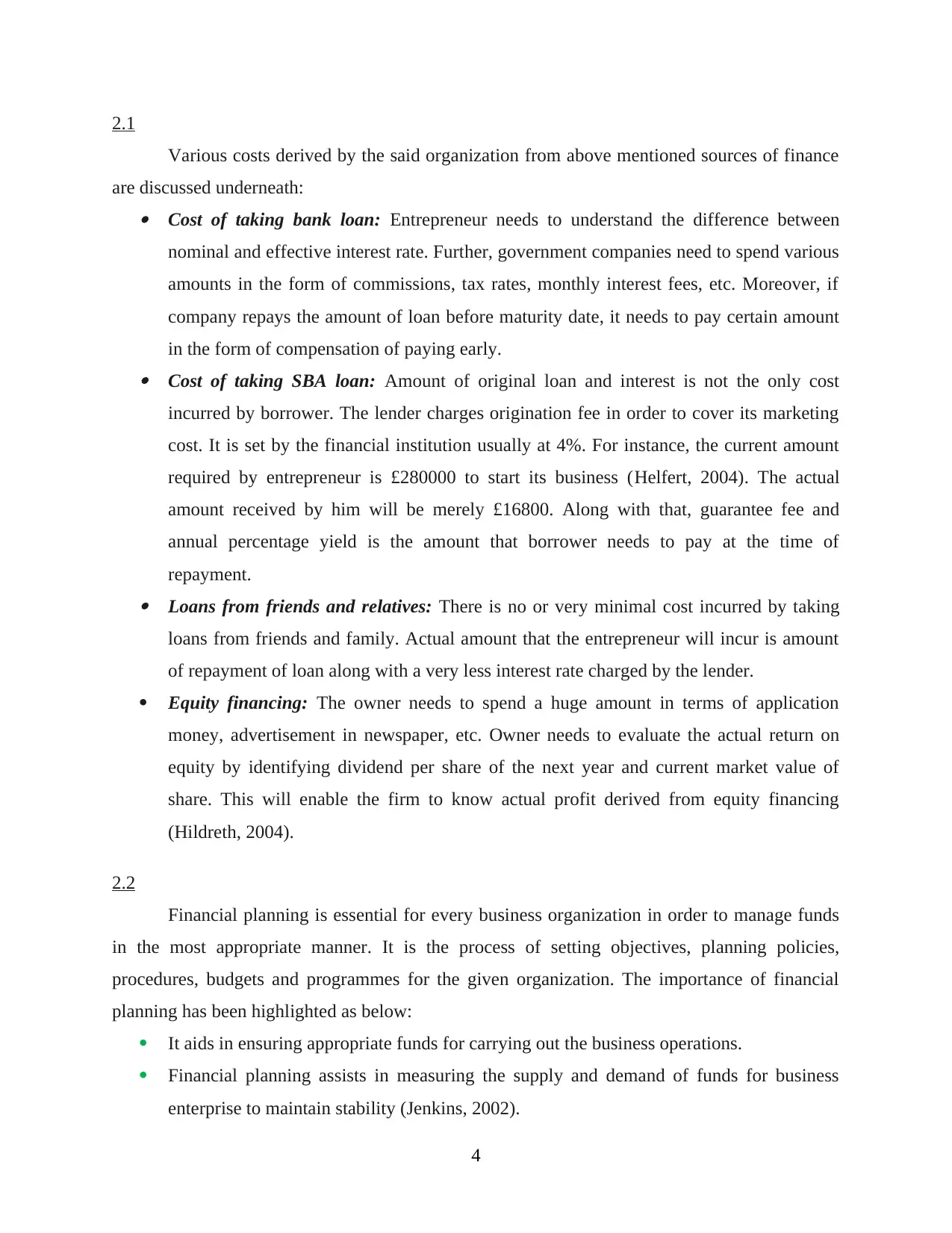
2.1
Various costs derived by the said organization from above mentioned sources of finance
are discussed underneath: Cost of taking bank loan: Entrepreneur needs to understand the difference between
nominal and effective interest rate. Further, government companies need to spend various
amounts in the form of commissions, tax rates, monthly interest fees, etc. Moreover, if
company repays the amount of loan before maturity date, it needs to pay certain amount
in the form of compensation of paying early. Cost of taking SBA loan: Amount of original loan and interest is not the only cost
incurred by borrower. The lender charges origination fee in order to cover its marketing
cost. It is set by the financial institution usually at 4%. For instance, the current amount
required by entrepreneur is £280000 to start its business (Helfert, 2004). The actual
amount received by him will be merely £16800. Along with that, guarantee fee and
annual percentage yield is the amount that borrower needs to pay at the time of
repayment. Loans from friends and relatives: There is no or very minimal cost incurred by taking
loans from friends and family. Actual amount that the entrepreneur will incur is amount
of repayment of loan along with a very less interest rate charged by the lender.
Equity financing: The owner needs to spend a huge amount in terms of application
money, advertisement in newspaper, etc. Owner needs to evaluate the actual return on
equity by identifying dividend per share of the next year and current market value of
share. This will enable the firm to know actual profit derived from equity financing
(Hildreth, 2004).
2.2
Financial planning is essential for every business organization in order to manage funds
in the most appropriate manner. It is the process of setting objectives, planning policies,
procedures, budgets and programmes for the given organization. The importance of financial
planning has been highlighted as below:
It aids in ensuring appropriate funds for carrying out the business operations.
Financial planning assists in measuring the supply and demand of funds for business
enterprise to maintain stability (Jenkins, 2002).
4
Various costs derived by the said organization from above mentioned sources of finance
are discussed underneath: Cost of taking bank loan: Entrepreneur needs to understand the difference between
nominal and effective interest rate. Further, government companies need to spend various
amounts in the form of commissions, tax rates, monthly interest fees, etc. Moreover, if
company repays the amount of loan before maturity date, it needs to pay certain amount
in the form of compensation of paying early. Cost of taking SBA loan: Amount of original loan and interest is not the only cost
incurred by borrower. The lender charges origination fee in order to cover its marketing
cost. It is set by the financial institution usually at 4%. For instance, the current amount
required by entrepreneur is £280000 to start its business (Helfert, 2004). The actual
amount received by him will be merely £16800. Along with that, guarantee fee and
annual percentage yield is the amount that borrower needs to pay at the time of
repayment. Loans from friends and relatives: There is no or very minimal cost incurred by taking
loans from friends and family. Actual amount that the entrepreneur will incur is amount
of repayment of loan along with a very less interest rate charged by the lender.
Equity financing: The owner needs to spend a huge amount in terms of application
money, advertisement in newspaper, etc. Owner needs to evaluate the actual return on
equity by identifying dividend per share of the next year and current market value of
share. This will enable the firm to know actual profit derived from equity financing
(Hildreth, 2004).
2.2
Financial planning is essential for every business organization in order to manage funds
in the most appropriate manner. It is the process of setting objectives, planning policies,
procedures, budgets and programmes for the given organization. The importance of financial
planning has been highlighted as below:
It aids in ensuring appropriate funds for carrying out the business operations.
Financial planning assists in measuring the supply and demand of funds for business
enterprise to maintain stability (Jenkins, 2002).
4
⊘ This is a preview!⊘
Do you want full access?
Subscribe today to unlock all pages.

Trusted by 1+ million students worldwide
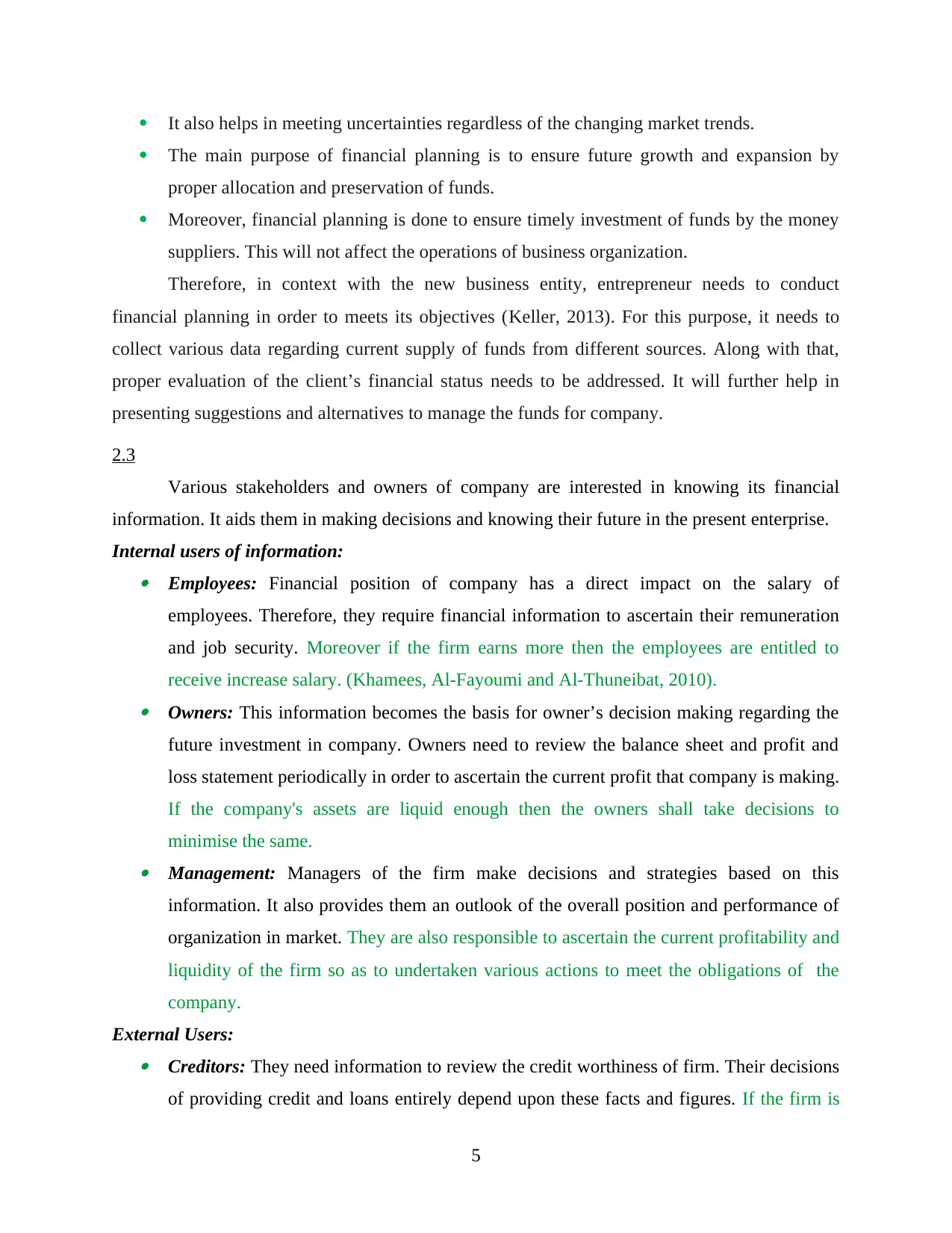
It also helps in meeting uncertainties regardless of the changing market trends.
The main purpose of financial planning is to ensure future growth and expansion by
proper allocation and preservation of funds.
Moreover, financial planning is done to ensure timely investment of funds by the money
suppliers. This will not affect the operations of business organization.
Therefore, in context with the new business entity, entrepreneur needs to conduct
financial planning in order to meets its objectives (Keller, 2013). For this purpose, it needs to
collect various data regarding current supply of funds from different sources. Along with that,
proper evaluation of the client’s financial status needs to be addressed. It will further help in
presenting suggestions and alternatives to manage the funds for company.
2.3
Various stakeholders and owners of company are interested in knowing its financial
information. It aids them in making decisions and knowing their future in the present enterprise.
Internal users of information: Employees: Financial position of company has a direct impact on the salary of
employees. Therefore, they require financial information to ascertain their remuneration
and job security. Moreover if the firm earns more then the employees are entitled to
receive increase salary. (Khamees, Al-Fayoumi and Al-Thuneibat, 2010). Owners: This information becomes the basis for owner’s decision making regarding the
future investment in company. Owners need to review the balance sheet and profit and
loss statement periodically in order to ascertain the current profit that company is making.
If the company's assets are liquid enough then the owners shall take decisions to
minimise the same. Management: Managers of the firm make decisions and strategies based on this
information. It also provides them an outlook of the overall position and performance of
organization in market. They are also responsible to ascertain the current profitability and
liquidity of the firm so as to undertaken various actions to meet the obligations of the
company.
External Users: Creditors: They need information to review the credit worthiness of firm. Their decisions
of providing credit and loans entirely depend upon these facts and figures. If the firm is
5
The main purpose of financial planning is to ensure future growth and expansion by
proper allocation and preservation of funds.
Moreover, financial planning is done to ensure timely investment of funds by the money
suppliers. This will not affect the operations of business organization.
Therefore, in context with the new business entity, entrepreneur needs to conduct
financial planning in order to meets its objectives (Keller, 2013). For this purpose, it needs to
collect various data regarding current supply of funds from different sources. Along with that,
proper evaluation of the client’s financial status needs to be addressed. It will further help in
presenting suggestions and alternatives to manage the funds for company.
2.3
Various stakeholders and owners of company are interested in knowing its financial
information. It aids them in making decisions and knowing their future in the present enterprise.
Internal users of information: Employees: Financial position of company has a direct impact on the salary of
employees. Therefore, they require financial information to ascertain their remuneration
and job security. Moreover if the firm earns more then the employees are entitled to
receive increase salary. (Khamees, Al-Fayoumi and Al-Thuneibat, 2010). Owners: This information becomes the basis for owner’s decision making regarding the
future investment in company. Owners need to review the balance sheet and profit and
loss statement periodically in order to ascertain the current profit that company is making.
If the company's assets are liquid enough then the owners shall take decisions to
minimise the same. Management: Managers of the firm make decisions and strategies based on this
information. It also provides them an outlook of the overall position and performance of
organization in market. They are also responsible to ascertain the current profitability and
liquidity of the firm so as to undertaken various actions to meet the obligations of the
company.
External Users: Creditors: They need information to review the credit worthiness of firm. Their decisions
of providing credit and loans entirely depend upon these facts and figures. If the firm is
5
Paraphrase This Document
Need a fresh take? Get an instant paraphrase of this document with our AI Paraphraser
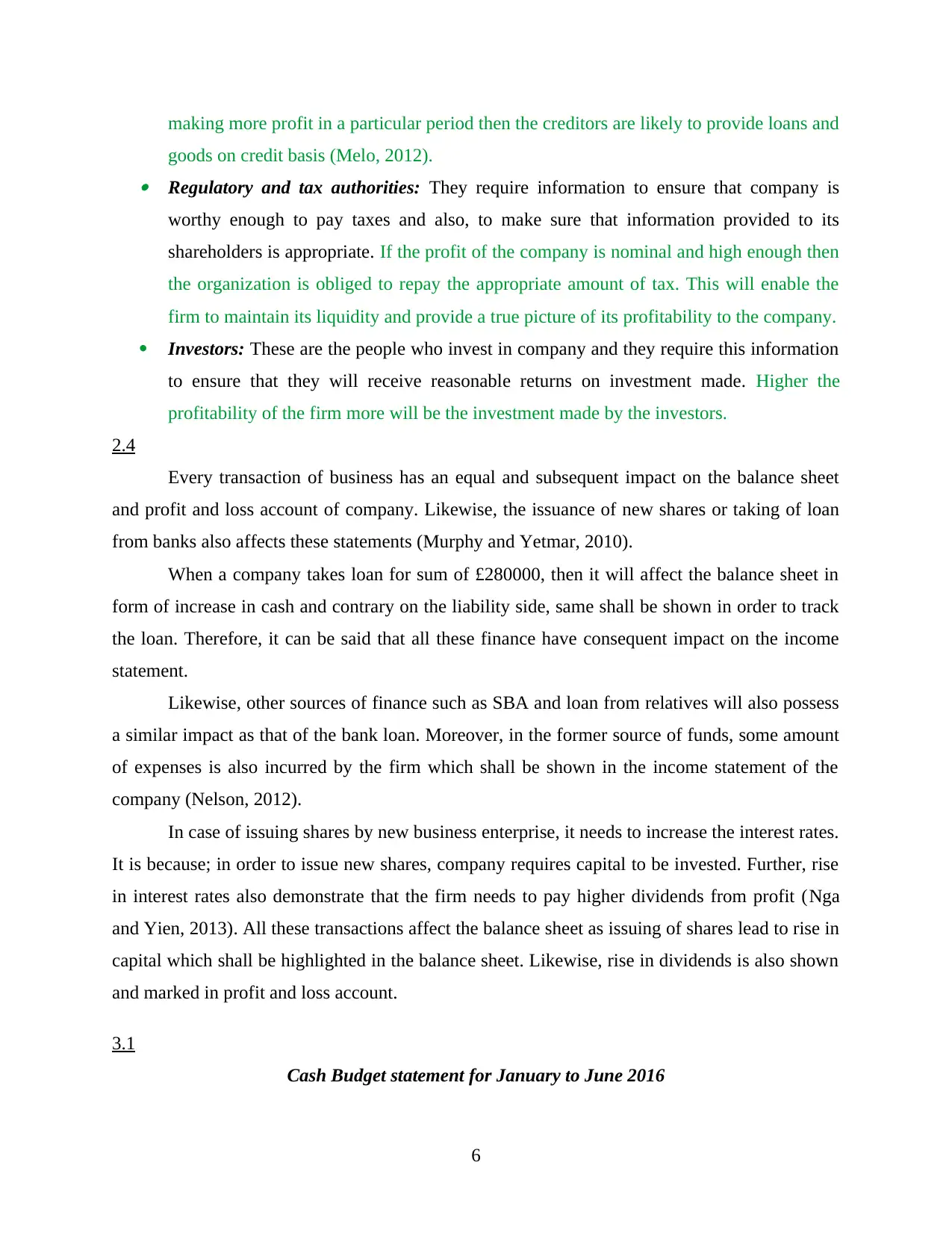
making more profit in a particular period then the creditors are likely to provide loans and
goods on credit basis (Melo, 2012). Regulatory and tax authorities: They require information to ensure that company is
worthy enough to pay taxes and also, to make sure that information provided to its
shareholders is appropriate. If the profit of the company is nominal and high enough then
the organization is obliged to repay the appropriate amount of tax. This will enable the
firm to maintain its liquidity and provide a true picture of its profitability to the company.
Investors: These are the people who invest in company and they require this information
to ensure that they will receive reasonable returns on investment made. Higher the
profitability of the firm more will be the investment made by the investors.
2.4
Every transaction of business has an equal and subsequent impact on the balance sheet
and profit and loss account of company. Likewise, the issuance of new shares or taking of loan
from banks also affects these statements (Murphy and Yetmar, 2010).
When a company takes loan for sum of £280000, then it will affect the balance sheet in
form of increase in cash and contrary on the liability side, same shall be shown in order to track
the loan. Therefore, it can be said that all these finance have consequent impact on the income
statement.
Likewise, other sources of finance such as SBA and loan from relatives will also possess
a similar impact as that of the bank loan. Moreover, in the former source of funds, some amount
of expenses is also incurred by the firm which shall be shown in the income statement of the
company (Nelson, 2012).
In case of issuing shares by new business enterprise, it needs to increase the interest rates.
It is because; in order to issue new shares, company requires capital to be invested. Further, rise
in interest rates also demonstrate that the firm needs to pay higher dividends from profit (Nga
and Yien, 2013). All these transactions affect the balance sheet as issuing of shares lead to rise in
capital which shall be highlighted in the balance sheet. Likewise, rise in dividends is also shown
and marked in profit and loss account.
3.1
Cash Budget statement for January to June 2016
6
goods on credit basis (Melo, 2012). Regulatory and tax authorities: They require information to ensure that company is
worthy enough to pay taxes and also, to make sure that information provided to its
shareholders is appropriate. If the profit of the company is nominal and high enough then
the organization is obliged to repay the appropriate amount of tax. This will enable the
firm to maintain its liquidity and provide a true picture of its profitability to the company.
Investors: These are the people who invest in company and they require this information
to ensure that they will receive reasonable returns on investment made. Higher the
profitability of the firm more will be the investment made by the investors.
2.4
Every transaction of business has an equal and subsequent impact on the balance sheet
and profit and loss account of company. Likewise, the issuance of new shares or taking of loan
from banks also affects these statements (Murphy and Yetmar, 2010).
When a company takes loan for sum of £280000, then it will affect the balance sheet in
form of increase in cash and contrary on the liability side, same shall be shown in order to track
the loan. Therefore, it can be said that all these finance have consequent impact on the income
statement.
Likewise, other sources of finance such as SBA and loan from relatives will also possess
a similar impact as that of the bank loan. Moreover, in the former source of funds, some amount
of expenses is also incurred by the firm which shall be shown in the income statement of the
company (Nelson, 2012).
In case of issuing shares by new business enterprise, it needs to increase the interest rates.
It is because; in order to issue new shares, company requires capital to be invested. Further, rise
in interest rates also demonstrate that the firm needs to pay higher dividends from profit (Nga
and Yien, 2013). All these transactions affect the balance sheet as issuing of shares lead to rise in
capital which shall be highlighted in the balance sheet. Likewise, rise in dividends is also shown
and marked in profit and loss account.
3.1
Cash Budget statement for January to June 2016
6
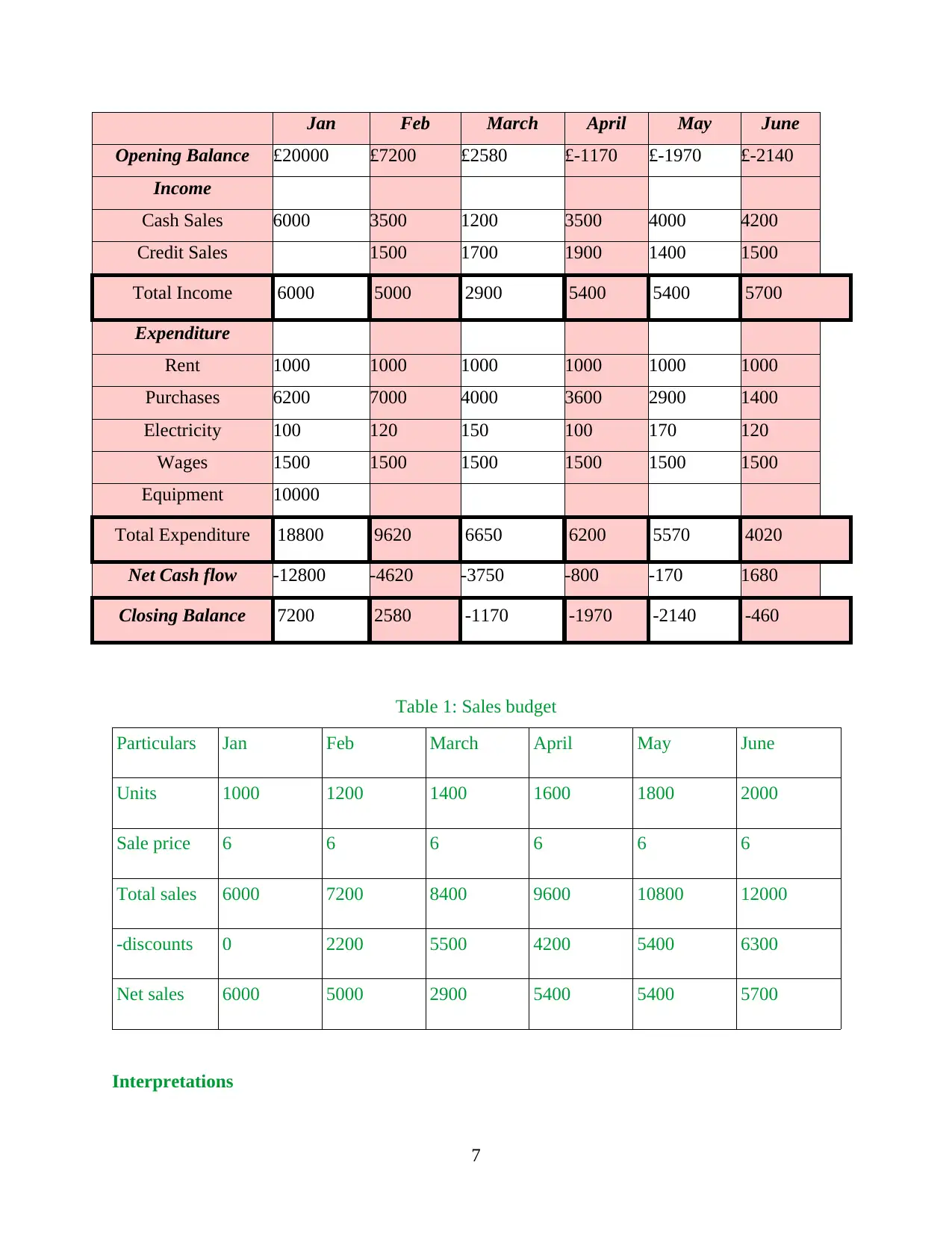
Jan Feb March April May June
Opening Balance £20000 £7200 £2580 £-1170 £-1970 £-2140
Income
Cash Sales 6000 3500 1200 3500 4000 4200
Credit Sales 1500 1700 1900 1400 1500
Total Income 6000 5000 2900 5400 5400 5700
Expenditure
Rent 1000 1000 1000 1000 1000 1000
Purchases 6200 7000 4000 3600 2900 1400
Electricity 100 120 150 100 170 120
Wages 1500 1500 1500 1500 1500 1500
Equipment 10000
Total Expenditure 18800 9620 6650 6200 5570 4020
Net Cash flow -12800 -4620 -3750 -800 -170 1680
Closing Balance 7200 2580 -1170 -1970 -2140 -460
Table 1: Sales budget
Particulars Jan Feb March April May June
Units 1000 1200 1400 1600 1800 2000
Sale price 6 6 6 6 6 6
Total sales 6000 7200 8400 9600 10800 12000
-discounts 0 2200 5500 4200 5400 6300
Net sales 6000 5000 2900 5400 5400 5700
Interpretations
7
Opening Balance £20000 £7200 £2580 £-1170 £-1970 £-2140
Income
Cash Sales 6000 3500 1200 3500 4000 4200
Credit Sales 1500 1700 1900 1400 1500
Total Income 6000 5000 2900 5400 5400 5700
Expenditure
Rent 1000 1000 1000 1000 1000 1000
Purchases 6200 7000 4000 3600 2900 1400
Electricity 100 120 150 100 170 120
Wages 1500 1500 1500 1500 1500 1500
Equipment 10000
Total Expenditure 18800 9620 6650 6200 5570 4020
Net Cash flow -12800 -4620 -3750 -800 -170 1680
Closing Balance 7200 2580 -1170 -1970 -2140 -460
Table 1: Sales budget
Particulars Jan Feb March April May June
Units 1000 1200 1400 1600 1800 2000
Sale price 6 6 6 6 6 6
Total sales 6000 7200 8400 9600 10800 12000
-discounts 0 2200 5500 4200 5400 6300
Net sales 6000 5000 2900 5400 5400 5700
Interpretations
7
⊘ This is a preview!⊘
Do you want full access?
Subscribe today to unlock all pages.

Trusted by 1+ million students worldwide
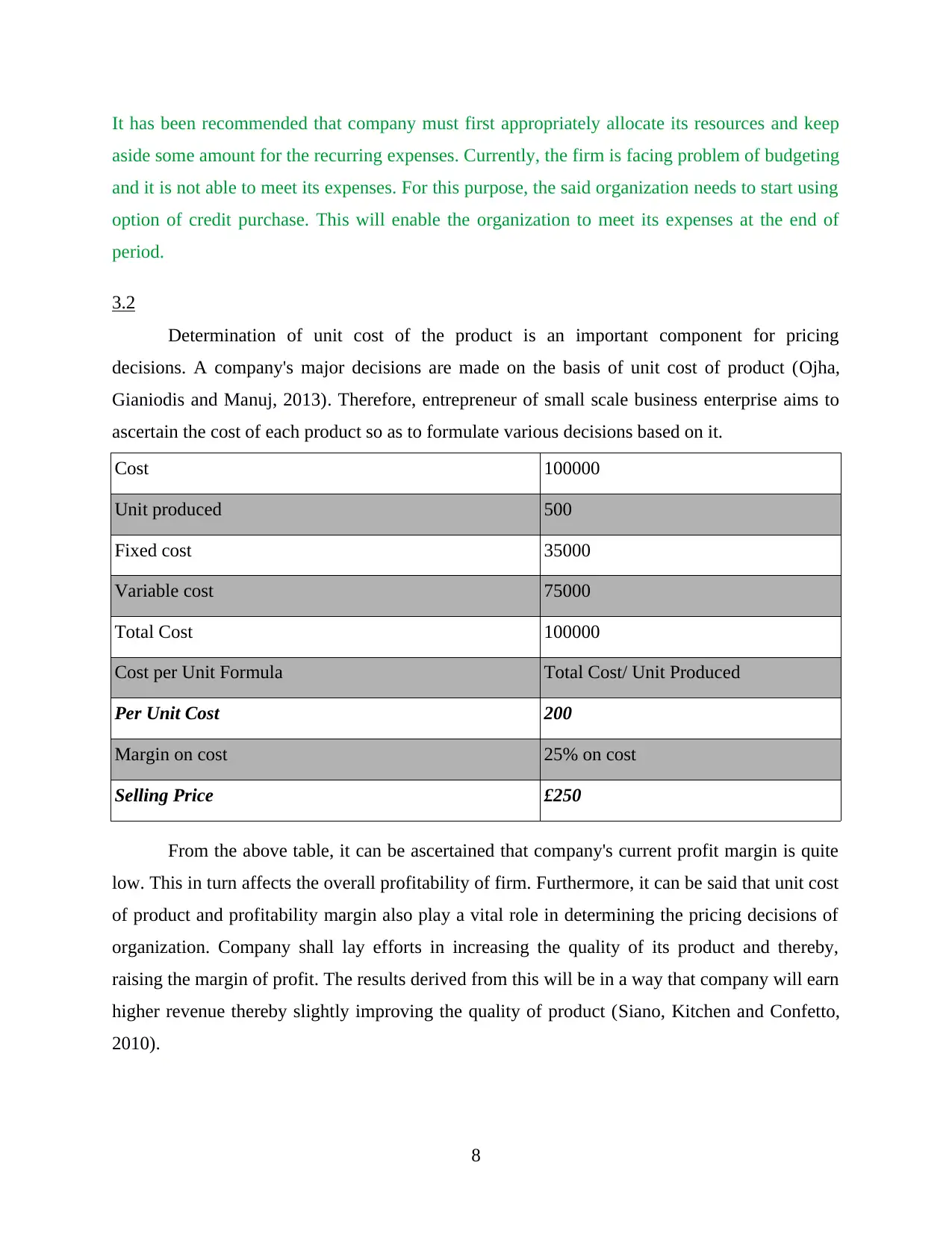
It has been recommended that company must first appropriately allocate its resources and keep
aside some amount for the recurring expenses. Currently, the firm is facing problem of budgeting
and it is not able to meet its expenses. For this purpose, the said organization needs to start using
option of credit purchase. This will enable the organization to meet its expenses at the end of
period.
3.2
Determination of unit cost of the product is an important component for pricing
decisions. A company's major decisions are made on the basis of unit cost of product (Ojha,
Gianiodis and Manuj, 2013). Therefore, entrepreneur of small scale business enterprise aims to
ascertain the cost of each product so as to formulate various decisions based on it.
Cost 100000
Unit produced 500
Fixed cost 35000
Variable cost 75000
Total Cost 100000
Cost per Unit Formula Total Cost/ Unit Produced
Per Unit Cost 200
Margin on cost 25% on cost
Selling Price £250
From the above table, it can be ascertained that company's current profit margin is quite
low. This in turn affects the overall profitability of firm. Furthermore, it can be said that unit cost
of product and profitability margin also play a vital role in determining the pricing decisions of
organization. Company shall lay efforts in increasing the quality of its product and thereby,
raising the margin of profit. The results derived from this will be in a way that company will earn
higher revenue thereby slightly improving the quality of product (Siano, Kitchen and Confetto,
2010).
8
aside some amount for the recurring expenses. Currently, the firm is facing problem of budgeting
and it is not able to meet its expenses. For this purpose, the said organization needs to start using
option of credit purchase. This will enable the organization to meet its expenses at the end of
period.
3.2
Determination of unit cost of the product is an important component for pricing
decisions. A company's major decisions are made on the basis of unit cost of product (Ojha,
Gianiodis and Manuj, 2013). Therefore, entrepreneur of small scale business enterprise aims to
ascertain the cost of each product so as to formulate various decisions based on it.
Cost 100000
Unit produced 500
Fixed cost 35000
Variable cost 75000
Total Cost 100000
Cost per Unit Formula Total Cost/ Unit Produced
Per Unit Cost 200
Margin on cost 25% on cost
Selling Price £250
From the above table, it can be ascertained that company's current profit margin is quite
low. This in turn affects the overall profitability of firm. Furthermore, it can be said that unit cost
of product and profitability margin also play a vital role in determining the pricing decisions of
organization. Company shall lay efforts in increasing the quality of its product and thereby,
raising the margin of profit. The results derived from this will be in a way that company will earn
higher revenue thereby slightly improving the quality of product (Siano, Kitchen and Confetto,
2010).
8
Paraphrase This Document
Need a fresh take? Get an instant paraphrase of this document with our AI Paraphraser
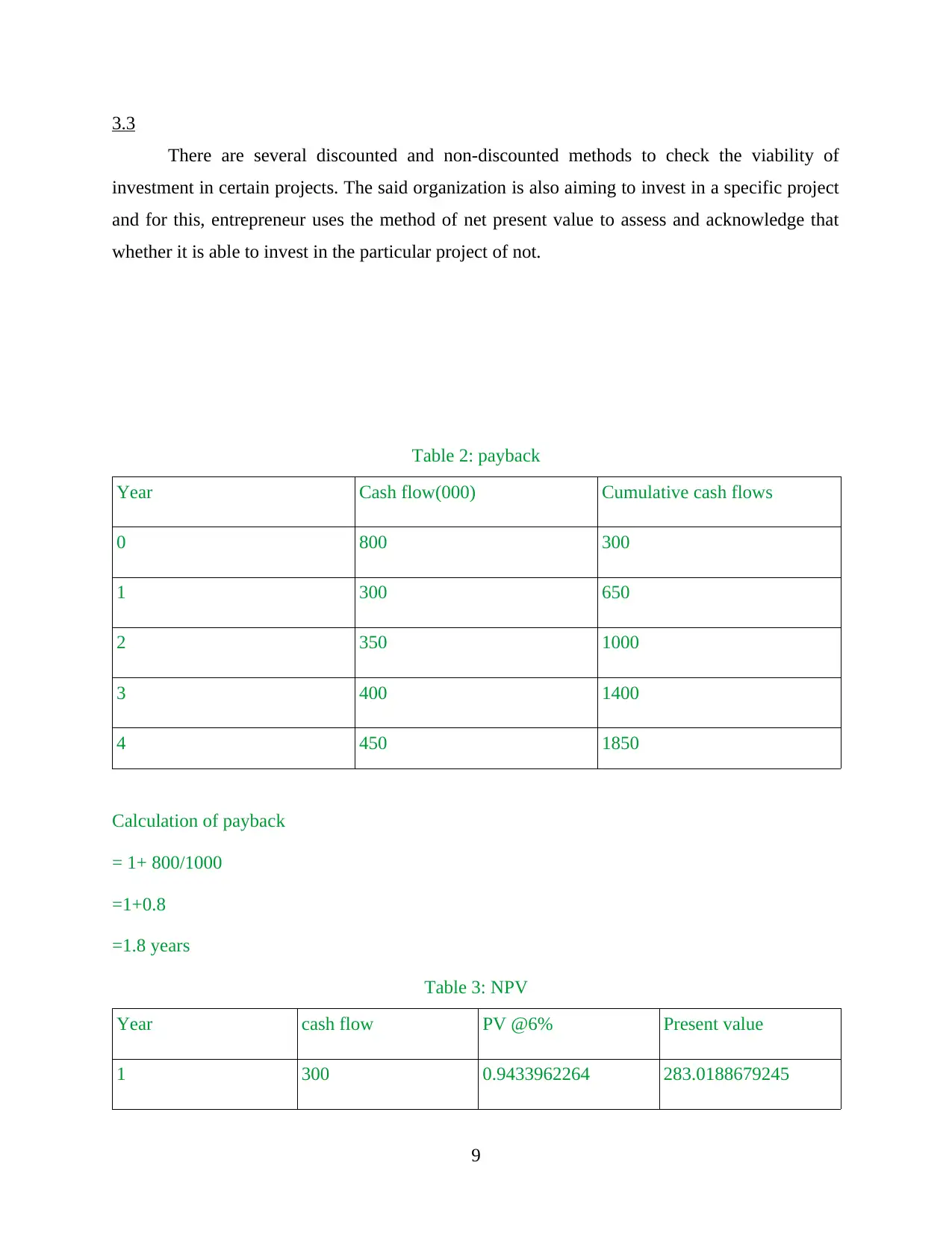
3.3
There are several discounted and non-discounted methods to check the viability of
investment in certain projects. The said organization is also aiming to invest in a specific project
and for this, entrepreneur uses the method of net present value to assess and acknowledge that
whether it is able to invest in the particular project of not.
Table 2: payback
Year Cash flow(000) Cumulative cash flows
0 800 300
1 300 650
2 350 1000
3 400 1400
4 450 1850
Calculation of payback
= 1+ 800/1000
=1+0.8
=1.8 years
Table 3: NPV
Year cash flow PV @6% Present value
1 300 0.9433962264 283.0188679245
9
There are several discounted and non-discounted methods to check the viability of
investment in certain projects. The said organization is also aiming to invest in a specific project
and for this, entrepreneur uses the method of net present value to assess and acknowledge that
whether it is able to invest in the particular project of not.
Table 2: payback
Year Cash flow(000) Cumulative cash flows
0 800 300
1 300 650
2 350 1000
3 400 1400
4 450 1850
Calculation of payback
= 1+ 800/1000
=1+0.8
=1.8 years
Table 3: NPV
Year cash flow PV @6% Present value
1 300 0.9433962264 283.0188679245
9
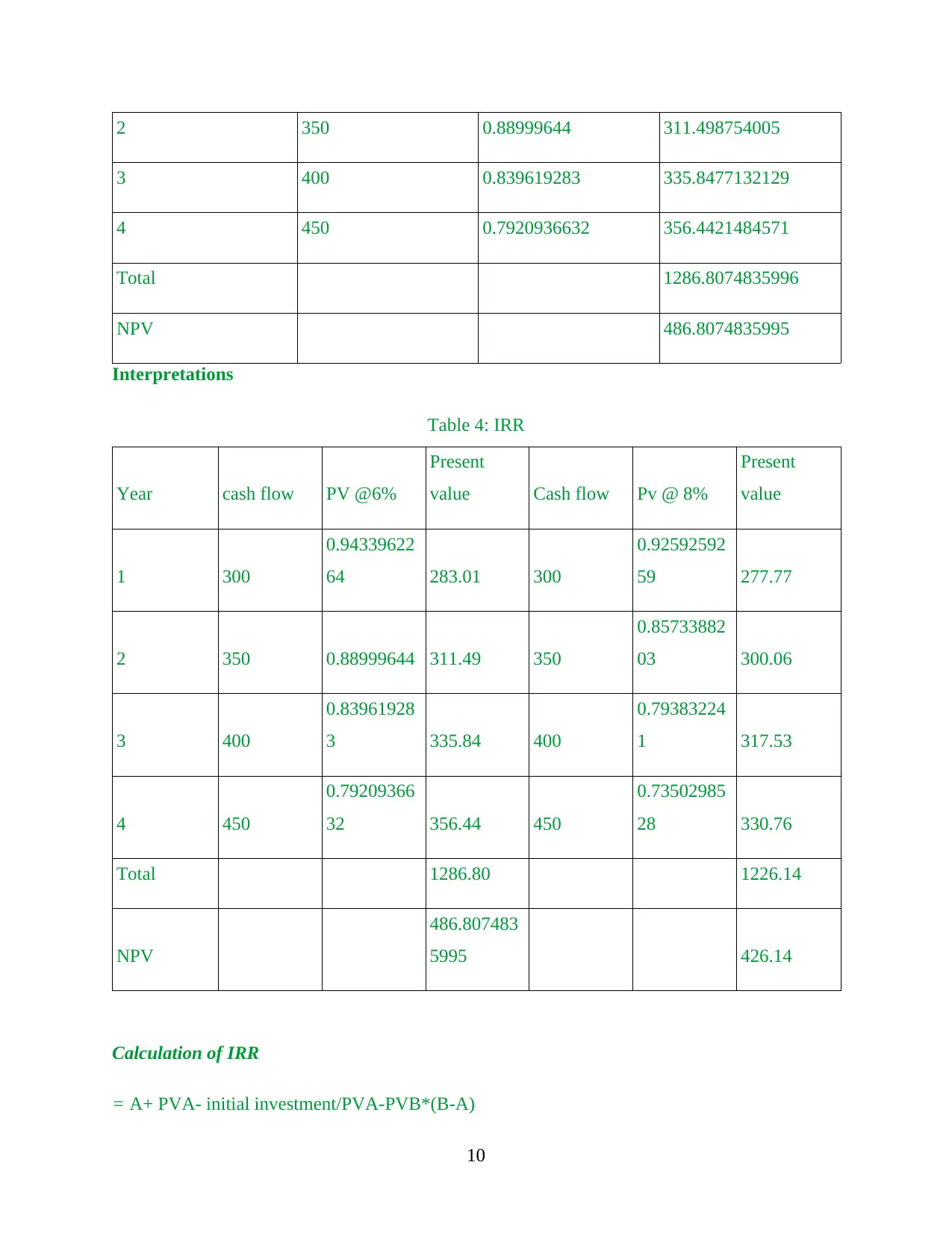
2 350 0.88999644 311.498754005
3 400 0.839619283 335.8477132129
4 450 0.7920936632 356.4421484571
Total 1286.8074835996
NPV 486.8074835995
Interpretations
Table 4: IRR
Year cash flow PV @6%
Present
value Cash flow Pv @ 8%
Present
value
1 300
0.94339622
64 283.01 300
0.92592592
59 277.77
2 350 0.88999644 311.49 350
0.85733882
03 300.06
3 400
0.83961928
3 335.84 400
0.79383224
1 317.53
4 450
0.79209366
32 356.44 450
0.73502985
28 330.76
Total 1286.80 1226.14
NPV
486.807483
5995 426.14
Calculation of IRR
= A+ PVA- initial investment/PVA-PVB*(B-A)
10
3 400 0.839619283 335.8477132129
4 450 0.7920936632 356.4421484571
Total 1286.8074835996
NPV 486.8074835995
Interpretations
Table 4: IRR
Year cash flow PV @6%
Present
value Cash flow Pv @ 8%
Present
value
1 300
0.94339622
64 283.01 300
0.92592592
59 277.77
2 350 0.88999644 311.49 350
0.85733882
03 300.06
3 400
0.83961928
3 335.84 400
0.79383224
1 317.53
4 450
0.79209366
32 356.44 450
0.73502985
28 330.76
Total 1286.80 1226.14
NPV
486.807483
5995 426.14
Calculation of IRR
= A+ PVA- initial investment/PVA-PVB*(B-A)
10
⊘ This is a preview!⊘
Do you want full access?
Subscribe today to unlock all pages.

Trusted by 1+ million students worldwide
1 out of 18
Related Documents
Your All-in-One AI-Powered Toolkit for Academic Success.
+13062052269
info@desklib.com
Available 24*7 on WhatsApp / Email
![[object Object]](/_next/static/media/star-bottom.7253800d.svg)
Unlock your academic potential
Copyright © 2020–2025 A2Z Services. All Rights Reserved. Developed and managed by ZUCOL.





